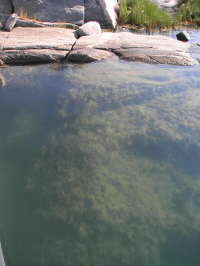Threats to Baltic Sea biodiversity
Excess nutrients threaten biodiversity

Eutrophication- the presence of excessive nutrients - has caused marked changes in Baltic ecosystems. The water is much less transparent than it was 30-50 years ago, due to the presence of more planktonic algae. This has forced plants that need light for photosynthesis out of deeper waters. Bladder wrack (Fucus vesiculosus) has also become less common along many rocky shorelines, while eel-grass (Zostera marina) - a plant that occupies a crucial ecological niche on sandy sea-beds in the southern and western waters of the Baltic - has also declined.
In addition, eutrophication leads to excess biomass of primary producers accumulating on the sea-bed, and the decomposition of this organic material consumes oxygen from the water. This leads to oxygen depletion, especially in areas where mixing of water is restricted, such as in deeper waters below the halocline, or in shallower waters affected by thermal stratification during the summer, resulting in the death of benthic organisms.
Hazardous substances accumulate up food webs
![exhaustfume[1].jpg exhaustfume[1].jpg](_files/72484892416673839/default/exhaustfume%5b1%5d.jpg)
Hazardous substances can bio-accumulate in marine food webs up to levels, which might be toxic to the organisms themselves, or to their predators. Thus, even human health might be affected. Sweden's Food Administration has in fact recommended that young women should limit their consumption of Baltic herring and salmon - fish that can accumulate high concentrations of hazardous substances in their fatty tissue.
Growing evidence suggests that PCBs and persistent halogenated aromatic hydrocarbons have reproductive and immunotoxic effects in wildlife, with effects on the liver, skin, immune systems, reproductive system, gastrointestinal tract and thyroid gland observed in laboratory rats. PCBs are classified as probable human carcinogens.
Seals in the Baltic Sea are now benefiting from declining levels of organic contaminants, although reproductive problems due to the effects of PCBs and dioxins are still widespread. An increasing number of young grey seals are suffering from chronic intestinal ulcers, thought to be caused by contaminants disturbing their immune systems.
The dangers of oil
![oilspillgulfbotnia[1].jpg oilspillgulfbotnia[1].jpg](_files/72484895824939123/default/oilspillgulfbotnia%5b1%5d.jpg)
Oil spills contaminate the surface water, smothering marine plants and animals. Many chemicals in oil spills are toxic, and can have serious cumulative effects as they build up in ecosystems. Spills can also have severe repercussions for tourism and fisheries, while the necessary clean-up operations may themselves unavoidably harm marine life and coastal habitats.
Impacts of fisheries
Present commercial fishing practices have environmental impacts throughout the whole Baltic Sea, affecting species such as harbour porpoises, seals and sea birds which are accidentally caught as by-catches, as well as the stocks of commercially fished species themselves.
Over-fishing can put entire marine ecosystems under pressure by changing their species composition and predator-prey ratios. Over-fishing of Baltic cod is currently a serious problem. One positive sign, however, is an increase in the productivity of wild salmon.
Shipping brings invasive species
Invasive species pose an increasing threat to eco-systems and the region's biodiversity. As shipping in the Baltic has increased during the last twenty years, more and more alien species have been arriving in the Baltic Sea as stowaways. Other non-native species have also been intentionally introduced. Inland waterways eventually connecting to the Black Sea and the Caspian Sea have helped still more exotic invaders to find their way to the Baltic. Once alien species establish a foothold, they can spread through to the other regions of the Baltic at speeds of up to 480 kilometres a year.
Non-native species can seriously disrupt ecosystems, and harm livelihoods. Fishermen in the Gulf of Riga and the Gulf of Finland remember the sudden arrival in 1992 of an alien water flea species. These tiny animals soon started to clog up the gills of fish and fishing nets, leading to serious economic losses. By 1998 the species had spread as far as Stockholm and Gotland.

